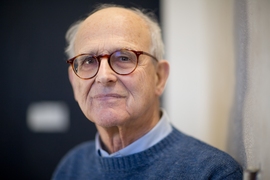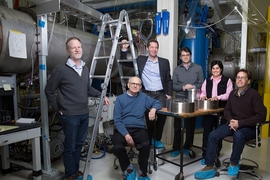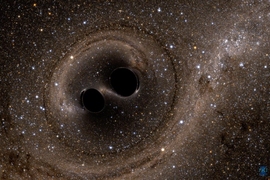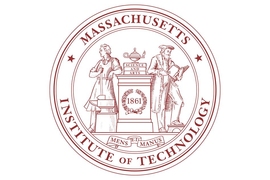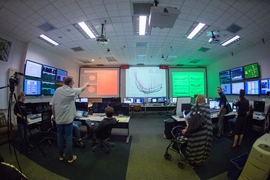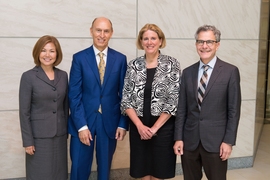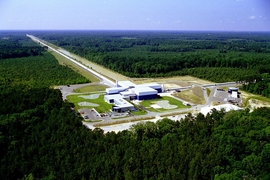Scientists from MIT and Caltech, along with others around the world, have made the first direct detection of gravitational waves reaching the Earth, using an instrument known as LIGO (Laser Interferometer Gravitational-Wave Observatory).
LIGO is a system of two identical detectors located 1,865 miles apart. Each detector consists of two 4-kilometer-long vacuum tubes, arranged in an L-shape, through which scientists send laser beams. As each beam reaches the end of a tube, it bounces off a mirror and heads back in the opposite direction. All things being equal, both laser beams should arrive back at their source at precisely the same time and, due to interference, cancel the light that would go to a photodetector. If, however, a gravitational wave passes through the detector, according to Albert Einstein’s predictions of 100 years ago the wave should stretch space in one tube while contracting the space in the other tube by an infinitesimal amount, thereby destroying the perfect cancellation and allowing light to reach the photodetector.
On Sept. 14, 2015, the LIGO Scientific Collaboration detected a very slight disruption in both detectors. After careful analysis, the researchers have confirmed that the disruption is indeed a signal of gravitational waves, originating from the merging of two massive black holes 1.3 billion light years from Earth.
Today, LIGO involves some 950 scientists at universities around the United States, including MIT, and in 15 other countries. But nearly four decades ago, the instrument was merely an MIT class exercise, conceived by Rainer Weiss, now a professor emeritus of physics. MIT News spoke with Weiss about the history of LIGO’s design and the 40-year effort to prove Einstein right.
Q: Where does the story of LIGO begin?
A: It started here in 1967. I was asked by the head of the teaching program in physics to give a course on general relativity. By the time 1967 had rolled around, general relativity had been relegated to mathematics departments. It was a theory of gravity, but it was mostly mathematics, and in most people’s minds it bore no relation to physics. And that was mostly because experiments to prove it were so hard to do — all these effects that Einstein’s theory had predicted were infinitesimally small.
Einstein had looked at the numbers and dimensions that went into his equations for gravitational waves and said, essentially, “This is so tiny that it will never have any influence on anything, and nobody can measure it.” And when you think about the times and the technology in 1916, he was probably right.
The big thing that’s happened in the last 100 years is, people discovered things in astronomy which were very different from what they knew in 1916 — tightly compact sources, enormously dense, like a neutron star, and black holes. And there was technology for doing precision measurements, because you had lasers, masers, electronics, computers, and a whole bunch of stuff people didn’t have in 1916.
So the technology and knowledge of the universe made it possible by the time we got into this, to contemplate trying to look for gravitational waves.
In the 1960s, Joseph Weber at the University of Maryland had the idea that maybe the technology had gotten to the point where you could look for gravitational waves, and he invented a method for doing that. He imagined a sort of xylophone made of a great big mass, called resonant bars. He expected a gravitational wave would come along and pull on one of the bars and squeeze it, and as the wave left, it would leave a pulse, and the thing would ring and you could hear it.
It was the first idea that you should do something active to go look for gravitational waves. And he had claimed a discovery in the 1960s.
When I taught my course, the students were very interested in finding out what this was. And I’ll be honest with you, I couldn’t for the life of me understand the thing he was doing. That was the problem. Because it completely countered every intuition I had now developed about general relativity. I couldn’t explain it to the students.
That was my quandary at the time, and that’s when the invention was made. I said, “What’s the simplest thing I can think of to show these students that you could detect the influence of a gravitational wave?”
The obvious thing to me was, let’s take freely floating masses in space and measure the time it takes light to travel between them. The presence of a gravitational wave would change that time. Using the time difference one could measure the amplitude of the wave. Equations for this process are simple to write and most of the students in the class could do it. Forget for a moment that this was a thought experiment requiring impossibly precise clocks. The principle was OK.
I didn’t think much more of it until about a year later, when I began to realize something about Weber’s experiments — nobody was getting the answer he was getting. He had made a huge and powerful claim. And I began to realize, maybe this was wrong, and maybe even his idea of how it works was wrong.
So I sat down one summer in a little room in Building 20, the “Plywood Palace” on Vassar Street, and worked the whole summer on the idea that I had talked with my students about. And knowing what you could do with lasers, I worked it out: Could you actually detect gravitational waves this way? And I came to the conclusion that yes, you could detect gravitational waves, at a strength that was much better than what Weber was looking for.
Q: What did it take to bring this idea into physical form?
A: We had been building a 1.5-meter prototype in RLE [the Research Laboratory of Electronics] using [military] funding, and were fairly well along. All at once funding was gone, due to the Mansfield amendment, which was a reaction to the Vietnam War. In the mind of the local RLE administrators, research in gravitation and cosmology was not in the military’s interest and support was given to solid-state physics, which was deemed more relevant. For the first time, I had to write proposals to other government and private agencies to continue our research.
Nobody was seriously working on gravitational wave interferometry yet, although as I learned later, others had thought about it as well. A German group at the Max Planck Institute in Garching had just been through building a Weber bar. They had worked with the Italians and found that Weber was wrong. They had probably done the very best experiment of anybody to show this. That was the mid ’70s.
They were asked to review my proposal to the National Science Foundation, just as they were thinking about the next thing to work on. They had been thinking, as many other groups in the world had at the time, to make even better Weber bars by cooling them to close to absolute zero. Instead they made a decision to try the interferometer idea. They called me to ask if there were any students that had been trained on the 1.5-meter prototype so that they could offer them a job. (At exactly the time they called there were none; a little later David Shoemaker, who had worked on the MIT prototype, did join the Garching group.) They then built a 3-meter prototype, got it working, and did a beautiful job.
Next they built a 30-meter one. By the time I got funding from the NSF and got going again, the German group had really solved most of the technical problems of the idea, and shown that all the calculations I had done were right on the money, that it worked just as calculated. They also added some ideas of their own that made it better.
A key step was in 1975: Because I was also doing studies in cosmic background radiation supported by NASA, I was asked by NASA to run a committee on uses of space research in the field of cosmology and relativity. What came out of that committee, for me, was that I met [Caltech physicist] Kip Thorne, whom I had asked to be a witness for the committee.
I picked Kip up at the airport on a hot summer night when Washington, D.C., was filled with tourists. He did not have a hotel reservation so we shared a room for the night. Kip had developed one of the best theory groups in gravitation at Caltech and was thinking of bringing an experimental gravitation group there. We laid out on a big piece of paper all the different experiments one could build a new group around. I told him about this thing we were working on. He had never heard about it, and he got very interested. What came of it was that Kip and I eventually decided Caltech and MIT would do this [project that became LIGO] together.
Q: This was an ambitious vision, with undoubtedly a long and complicated history. What were some key moments that drove the project forward?
A: In the later 1970s, the MIT group, now including Peter Saulson and Paul Linsay, did a study with industry to determine the feasibility of building a large, kilometer-scale gravitational wave interferometer. The study looked at how to make large vacuum systems and considered how to develop scaling laws for costs, the possible sites where one could build 5- to 10-kilometer L-shaped structures with minimum earth-moving, and the availability of optics and light sources. We looked at the possible sources of gravitational waves and several competing interferometer concepts that had been prototyped in different labs in the world. The information was put in a report, called the Blue Book, and presented to the NSF in 1983. Scientists from Caltech and MIT together presented the ideas developed in the Blue Book, as well as the results of the prototype research.
The proposal we presented was to make a detector system sensitive enough to actually detect gravitational waves from an astrophysical source (not just a new prototype). The proposal was to build two detectors. You couldn’t do science with one; you had to have two separate detectors, equally sensitive, and long enough.
That was a real struggle later on. You wanted to maintain those ideas, and people later wanted to shave it down: Why not just build one long one? Why build it so long? All these arguments were made but we stuck it out. We had to, otherwise we would never have survived and we wouldn’t be here today. We got an endorsement from the committee: risky research with the possibility of a profound outcome well worth considering as a new project by the NSF.
By the mid 1980s, NSF kept trying to figure out how to start this. Then in 1986, an interesting thing happened that finally broke the logjam. Richard Garwin, who had worked with Enrico Fermi [1938 Nobel laureate in Physics] and with the Department of Energy, and made all the calculations and did the actual development of the first hydrogen bomb, had become chief scientist of IBM. He had read about Weber’s experiments and decided with another IBM associate to build a little one, much smarter than what Weber had built — and he saw nothing.
NSF was trying to sell this huge new program for gravitational waves. Garwin gets wind of it, and he thought he had slayed this dragon. He wrote a letter to the NSF saying, “If you’re going to persist with this, you’d better have a real study.”
So we ran a study at the American Academy of Arts and Sciences on Beacon Street in Cambridge. It was a one-week meeting with an excellent committee of hard-nosed scientists. The recommendation the committee made was unbelievably good: The project is absolutely worth doing, don’t divide it up into one detector at a time, make it the full length, no more prototypes. It also recommended a change in the management of the project to have a single director rather than a steering group, which was the way we had managed the project.
By 1989, we wrote another proposal under the direction of Rochus Vogt [a former Caltech provost], which took us almost six months to write — it was a masterpiece. The proposal was to build two sites with 4-kilometer-long interferometers. The interferometers were to be staged. The first detector was based on the research, now reasonably mature, from the prototypes with a sensitivity that offered a plausible chance for detection. The second detector was based on newer advanced concepts that had not yet been fully tested but that offered the capability of a good chance for detection. The proposal made it through the National Science Board, got accepted, and money started coming in significant amounts.
By the 1990s, the rest of the history is easier. Now under the direction of Barry Barish [a Caltech physics professor] the sites were being built and developed, vacuum systems were made, and we started running the first detectors. By 2010, we had run and made vast improvements in their sensitivity but had seen nothing. It was a clean nothing; the detectors had run at design and we saw no anomalies that could be interpreted as gravitational waves. Based on the fact that we [had achieved our desired] design sensitivity and had carried out the science to determine some interesting upper limits on possible sources, we received funding to build Advanced LIGO.
Q: How momentous for you is this discovery?
A: As far as having fulfilled the ambitions of a lot of us who have worked on this project, it is momentous. It’s the signal that all of us have wanted to see, because we knew about it, we had never had real proof of it, and it’s the limit of Einstein equations never observed before — the dynamics of the geometry of space-time in the strong [gravitational] field and high velocity limit.
To me, it’s a closure to something which has had a very complicated history. The field equations and the whole history of general relativity have been complicated. Here suddenly we have something we can grab onto and say, “Einstein was right. What a marvelous insight and intuition he had.”
I feel an enormous sense of relief and some joy, but mostly relief. There’s a monkey that’s been sitting on my shoulder for 40 years, and he’s been nattering in my ear and saying, “Ehhh, how do you know this is really going to work? You’ve gotten a whole bunch of people involved. Suppose it never works right?” And suddenly, he’s jumped off. It’s a huge relief.
